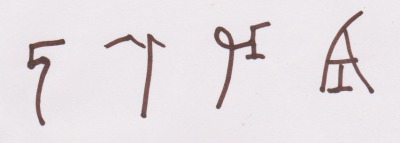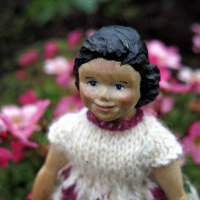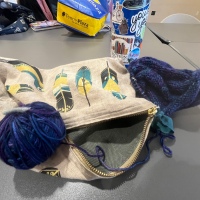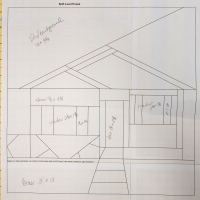I Love Linear B!
When Knossos was excavated, thousands of small clay tablets were found. Some of their symbols were pretty easy to figure out:
and some weren’t.
(I am drawing them myself, because I have a stunning lack of knowledge about things like how to download fonts, and I would rather spend on time on ancient textiles instead of a computer process that will probably be obsolete tomorrow anyway.)
By 1902, Arthur Evans had separated them into three distinct types, a hieroglyphic script that was rarely turned up in the digs, and then two forms that looked like simplified forms of the hieroglyphs. They were made with incised lines instead of pressed wedges like cuneiform, so he called them Linear A and Linear B. Some of the symbols were shared in those two systems, but not all. And no one knew what language they represented.
Evans had uncovered more than 2000 tablets of Linear B, but up until his death in 1941, he allowed less than 200 of them to be published. He was a busy man, being keeper of the Ashmolean museum at Oxford, and “reconstructing” Knossos, but from what I’ve read, I think he was hoping to decode them himself, and didn’t want anyone to get a jump on him.
Margalit Fox’s book The Riddle of the Labyrinth: The Quest to Crack an Ancient Code tells the story of how the symbols finally were decoded, and as one Booklist reviewer has written, “You might think a story about trying to decipher a 3000 year-old-language wouldn’t be particularly exciting, but in this case you’d be wrong.” Fox makes the story zip along, and interweaves background information on languages and history. The first third of the book is about Arthur Evans, and then she focuses on two people who were instrumental in solving the code.
The first, Alice Kober, was a professor of classics who spent her spare time working on the riddle. Unlike other people who were trying to fit a known language into the writing system, she analyzed the symbols themselves. This was before computers, so she had to come up with her own data base system. She made thousands of tiny punch cards and notes, so small she could store them in cigarette boxes, to record symbol occurrences and combinations. Her archive is at the University of Texas at Austin with some images available online. Here is a good summary of Kober’s contribution, to tide you over until you have time to read the whole book.
Sadly, she died in 1950, at the age of only 43, before solving the puzzle, but her work was instrumental in aiding the man who did decode Linear B in 1952.
He was an English architect named Michael Ventris, who had spent years believing the language was Etruscan. Finally he figured out that it was a very early form of Greek, from seven hundred years before Greek was known to exist!
(Does that mean that the Minoans were actually Greek? NO! Their hieroglyphic symbols and Linear A have still not been decoded. We still don’t know their language.
What it does mean – and I am very unclear on the details of events, but it seems so are the experts – is that sometime about 1400 BC, people from Mycenae on the Greek mainland, took over administration on Crete. The textile production system changed dramatically, but we are going to have to wait until next time to get into those details.)
So! Now that Evans’ 2000 tablets (and all the other Linear B tablets that had been uncovered in the meantime) could be decoded, what did they say?
As Alice Kober had guessed they might be, they were essentially inventory records, “Farmer Brown delivered a cow to Official Green.” There are no sagas and epic poems in the tablets we have.
Apparently this was very disappointing to a lot of people, but this is exactly why I love Linear B.
How many ancient battle sagas do we really need? When I look back into history, I like to balance the picture a little and look at many aspects of life. I like to know what everybody back at home was doing while the armor-clad warriors were roaming around clashing their swords on their shields.
Linear B provides a detailed picture of ordinary life. It turned out to be a syllabic script, with some ideograms sprinkled in. In other words, there are about 100 signs that stand for a consonant-vowel combination, and about 250 signs, that mean a whole word. I’ll give you the charts for the syllabary and the ideograms. (These are by the Unicode Consortium. I don’t find these an especially easy form to work with, but it is fun to look at the symbols and see if you can figure them out.)
Here’s how I would write “Textile Ranger” –
Contented sigh. Even if I hadn’t learned a thing about how to read them, I just like the looks of them. They are such artistically satisfying little symbols!
Okay, on to some actual linguistic information. Since I am putting English words into Linear B script, I have to make some decisions. There is no “x”, so I am using a “ke” syllable, followed by the “se” syllable. And there is no “l” sound, so I am substituting the “re” syllable. (And I have good precedent for that – our word “linen” is written in Linear B as “ri-no.”)
When I get to the word “ranger”, I can either add another syllable for the “re” sound at the end, or I can leave off that final sound like I did here. I also could have used the “je” syllable, but it just so happens that the “ja” syllable I picked instead, is the feminine ending for words – and it looks like a vertical loom! If you read these syllables aloud, you would realize they aren’t perfect English words, but eventually you might figure out which English words they stand for.
And that is apparently what the Mycenaeans did with the existing Minoan language when they took over Crete. They saw a writing system, realized its benefits, and changed it to meet the needs of their own language.
So next time I will be able to get to the actual information we have about textile production in Mycenaean times. It is pretty amazing – thousands of sheep! Quotas! Cloth that supposedly weighed 60 pounds for one unit! Specialized words for spinners, weavers, decorators, and fullers!  Until then I will leave you with the known symbols for six different kinds of cloth.
Until then I will leave you with the known symbols for six different kinds of cloth.
When I look at the one fourth from the left, I see a cloth that is woven all the way across on top, then woven with two shuttles to make a split down the middle, like a modern poncho type of garment. So that makes me think that the one second from the left, could be a doublewoven tube, with a slit in the middle, and top and bottom woven all the way around. The others have me stumped though!
Some of them have been figured out, but some haven’t. If you are a weaver, what are your ideas?
Oh! And in a development that Alice Kober would have loved, the Linear B tablets are now online, with a spectacular technology called Reflectance Transformation Imaging. You can download the free RTI viewer, (and this link is more up-to-date than the one on the Ashmolean page of images) and then access the high resolution images on the web. You can zoom in and look at the image in all different angles of strong light.
And here is a great page of links to resources about the Minoan culture.




















Wow I love these symbols, i haven’t seen anything like that in years x
Me too! I’m thinking they might turn up in one of my quilts or something! 🙂
Man! I have trouble enough with English. I live here. I have a live fish. And all that kind of stuff that we have. Well, have fun with your pre-Greek Greek. I know you will. 🙂
“Pre-Greek Greek” would have been a better name for it than Linear B. Too bad they didn’t know what it was when they named it! 🙂
The symbols are fascinating. Interesting post, thanks for sharing.
This post made me smile, the whole way through! It’s so clear you’re getting a huge kick out of all of this and your enthusiasm is really contagious!
By now you may have come across Tom Palaima’s name, or the Pre-Aegean scripts project (PASP) at UT Austin. I forget how close you are to Austin, but Palaima and PASP are some of the best pre-Greek resources in the Anglophone world. Should you want to pursue this new interest more directly 🙂
I had no idea that UT had Kober’s notes archived and (partly) digitized. VERY cool.
Calligraphers and paleographers think the bright idea for writing in lines originated with the process of weaving, ‘text’ and ‘textile’ obviously being the same word. Great posts, thank you so much for the erudite writing on a topic which fascinates me.
You may already know this, but one of the differences between Linear A and B is that B was written on clay tablets that had been prepared with lines ahead of time, and A was just marked down without them. But I didn’t know about the weaving connection, so thank you!
Oh, that is very interesting, I don’t think I knew that, but I have a piece on page 5 of my blog that might be alluding to it anyway. Might have been something a mentor mentioned that got tucked away in a corner of my mind!